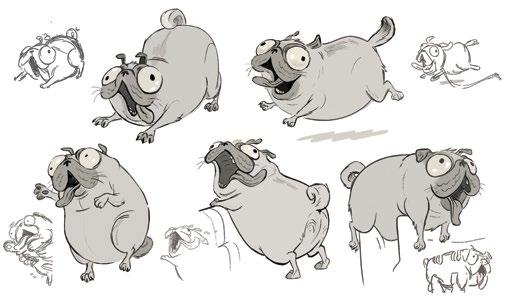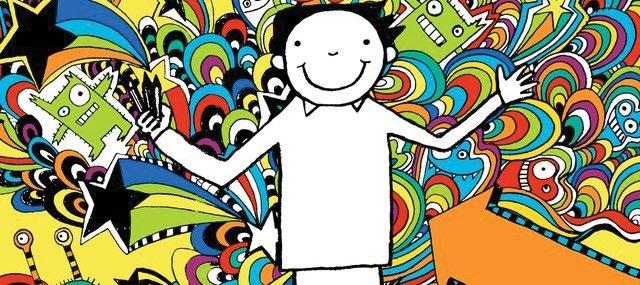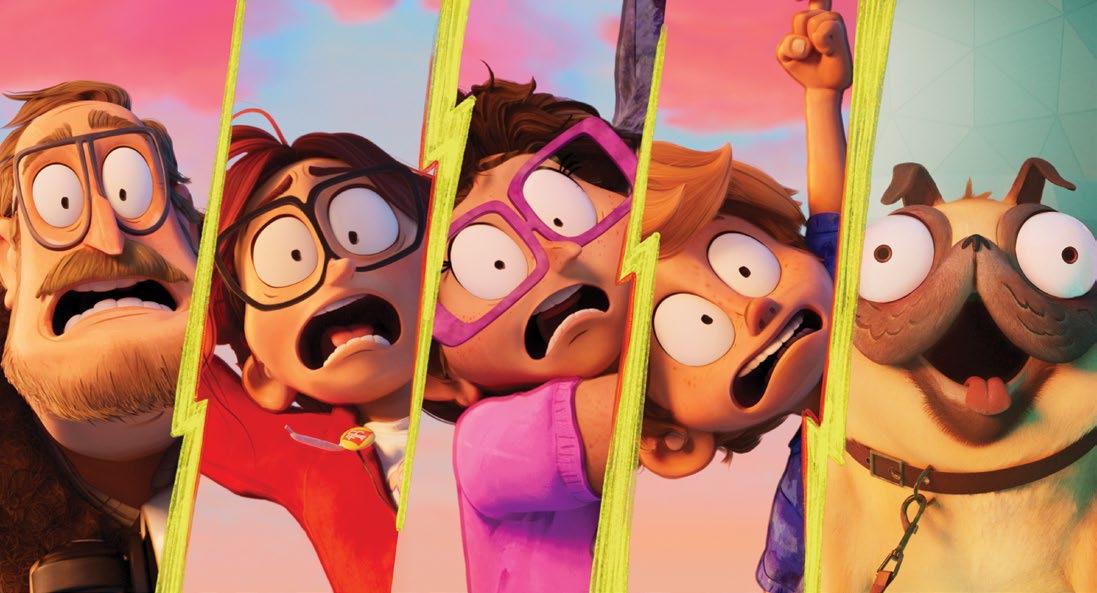
9 minute read
Welcome to the Fun Robocalypse
Writer-director Mike Rianda gives us a special sneak peek at his inventive, funny and ultimately poignant family feature The Mitchells vs. the Machines. By Ramin Zahed
Writer-director Mike Rianda has a lot of great memories growing up with his brother and sister in a tightly knit family in Salinas, Calif. He also loves dinosaurs, robots, apocalyptic movies and pop culture. You can fnd a lot of his favorite things in the hilarious and highly original new animated feature The Mitchells vs. the Machines. Although the theatrical release of the Sony Pictures Animation title (which was renamed Connected for a while) fell victim to the pandemic last fall, audiences can fnally enjoy the feature when it premieres on Netfix in May.
Rianda, who was the creative director on Disney Channel’s acclaimed series Gravity Falls, recalls how he came up with the idea for the movie back in December 2014. “I wanted to make the kind of animated movie that my friends and I would want to see,” he explains. “I remember taking a long car drive from L.A. to Salinas, so I turned on my tape recorder and came up with the story that eventually became this movie. I love my own weird family, and I love robots. My own dad (who is the inspiration for Rick Mitchell, the father in the movie) is an outdoors person, and he hates technology so much. I thought it would be really funny if he was caught up in a robocalypse. I also know that every family is dealing with technology and how it can come between parents and their kids. So all these ideas merged together as I sat down to write the movie.” The flm, which is co-directed by Jeff Rowe (writer on Gravity Falls and Disenchantment), follows the adventures of a typical suburban family who take a road trip to drop off artistic older daughter Katie (Broad City’s Abbi Jacobson) at flm school in California. However, they

Through Katie’s Eyes: The film’s creative team used fun, eye-catching visuals to show how the young, artistic heroine of the movie sees the world.
fnd themselves in the strange position of saving the world from a sinister robot takeover. Danny McBride and Maya Rudolph voice the parents, while Rianda himself voices younger brother Aaron and celebrity pup Doug the Pug lends his snorting talents to the family’s pug, Monchi! The flm also includes hand-held computer visionary Dr. Mark Bowman (voiced by Eric André) and his needy Alexa-esque personal assistant PAL (Olivia Colman).
“One of the reasons the movie really strikes a chord is because the material feels autobiographical,” says Kristine Belson, Sony Pictures Animation President. “Mike Rianda is a creative force, very much like Katie Mitchell, and the movie delicately handles that universal idea of the generational divide, which happens when parents and their kids don’t value the same things and fail to understand each other. We felt that The Mitchells was the perfect opportunity for us to explore this fresh world which was quite different from all the other movies we had done in the past.”
Belson also points out that Rianda and his artistic team wanted the central family to be unlike other animated clans of the big screen. “The families we often see in animated movies are often whitewashed and glossed over,” she says. “What we loved about Rianda’s vision was the way he and his team created a world that refected how real people live today. The Mitchells live in a modest home in the Midwest. They don’t have time to make their beds every day ‘As corny as it sounds, the pandemic really reminded us how important we all are to each other and how we go crazy when we can’t see each other. I’d run through a brick wall to be able to hug my parents right now.’

— Writer/director Mike Rianda
and make sure everything is completely neat and organized. They shop at discount stores and the carpet in the house is threadbare. But they treat everything with love.”
The Lord and Miller Touch
Also helping out with the movie were exec producers Phil Lord and Chris Miller, who felt an instant kinship with the director after they met him at Sony as they were fnishing work on Spider-Man: Into the Spider-Verse. “We were really inspired by Mike, his story and his ability to tell a joke, but also care about the emotionality of it,” says Lord. “It can make you laugh and make you cry. We thought, that’s an instant win. Someone who is really good at both things would be a good person to be in business with.” Miller also praises Rianda’s team for really pushing the flm in terms of its original visuals. He explains, “Mike’s goal was to bring a homemade, handcrafted feel to the project, so when we see things through Katie’s POV, he wanted it to feel like her mixed-media student flms. That’s why the studio developed a watercolor style for the movie, so that every frame felt hand-painted and we see this story through ‘Katie Vision,’ which bursts with creative energy and dazzling colors.”
One of the stand-out qualities that sets Mitchells apart from other big CG-animated studio fare is its unique visual stamp. “Big studio animated movies are often beautiful,” explains Rianda. “Audiences are just accustomed to seeing a very high level of incredible artistry on the big screen. We were thinking that if we ever got to do our own movie, we would have the chance to do things a little bit differently. Our production designer Lindsey Olivares came up with these amazing early drawings for the movie, and we thought, ‘Wow, what if the movie looked just like your drawings?’“
For Rowe, the movie stood out as a wonderful tribute to the characters that both directors knew and identifed with. “I love that the movie is very observed and naturalistic,” says Rowe. “I mean, yes we have laser-shooting giant Furbys and a robot city, but at its core, it’s a very well-grounded movie. We pay a lot of attention to the details of the characters. They feel complex emotions and have faws and wants that are in opposition to each other. We were hoping to offer more emotional depth than your average animated movie.”
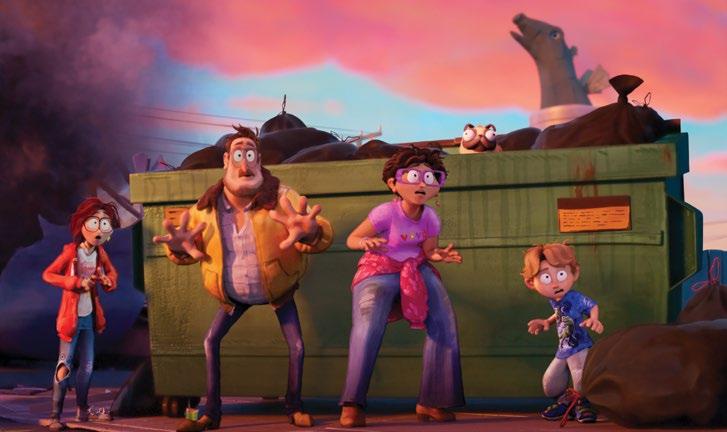
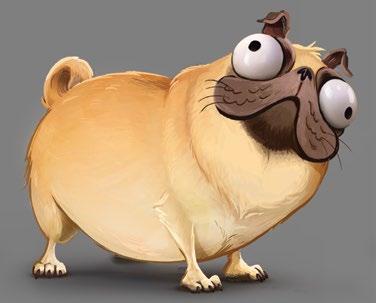
According to Rowe, making the movie felt like walking on a balance beam, where you had to fall on the side of technology or humanity. “It felt it was too easy to say, ‘Oh, look, technology and phones are ruining the world. Nobody retains information anymore!’ But then, it just felt untrue. We felt like old men who were shaking their fsts in the air and saying, ‘Put down your phones, kids!’ We didn’t believe any of that and didn’t want it to be the message of the movie. Technology can be amazing. You can meet like-minded people from all over the world. Katie Mitchell has tools that no other generations before had access to. She can shoot and edit movies on her own, etc. Both Mike and I want the movie to say that a good balance is what we need. It’s good to embrace the positive aspects of technology, but it’s wrong to use it to avoid dealing with the world.”
To get the details of the Mitchells’ car trek across America right, Rianda, Rowe and some of the key members of the art and design team decided to plan a road trip themselves. “I told them we could go to my family’s house in Salinas or we can go to Las Vegas, and they picked Vegas, of course,” says Rianda. “One of the storyboard artists suggested that we stop using our cell phones and see what happens. So as soon as we put our phones in a bag, we started having really great, intimate conversations. It was funny how we started connecting as soon as the technology went away!”
The director and his team have waited a long time for their labor of love to reach their target audience. But Rianda mentions that the extra time allowed them to fne tune all the jokes and nuances. “One thing we learned from working with Chris and Phil is the way we combed through the movie over and over again and made little adjustments and improvements,” he points out. “It’s really an evolution as we try these sporadic mutations based on everyone’s guts. You give birth to these changes: Some of them die and some fourish, so you hang on to the ones that are successful. As a result, we did a lot of screw-tightening.”
Worth the Wait
Looking back, Rianda says he’s very happy with the fnal results. “I can say that I don’t
All in the Family: The film’s loving Mitchell family was inspired in part by writer-director Mike Rianda’s own parents and siblings. The family dog Monchi is voiced by Doug the Pug!
— Writer/co-director Jeff Rowe
have any regrets as I watch the movie. As awful as the COVID year was, the thing that I was impressed with was how much we were able to connect with each other via Skype and Zoom, and we were able to fnish the movie with relative ease. Without the technology, we wouldn’t have been able to do this.”
Technology also helped Rianda screen the movie with his family and the cast and crew. “I was more nervous showing the movie to my family than the rest of the world,” he admits. “They have always been tough critics to please, but they really loved this one. Our Zoom screening was amazing. My dad was showing all his hunting stuff to the crew and they were cheering him on!”
As we get towards the end of our interview, Rianda says, “As corny as it sounds, the pandemic really reminded us how important we all are to each other and how we go crazy when we can’t see each other. I’d run through a brick wall to be able to hug my parents right now. So, you fnd yourself grateful to technology because it lets you interact with your family and friends.”
“I really do hope that if a kid is watching the movie, he or she can laugh at the jokes, but also appreciate what their parents are going through,” he notes. “Also, I hope parents realize that maybe they’re not paying enough attention or encouraging their children enough. I guess we’re trying to bring families together. On a less grand scale, I hope families can watch our movie together, just like my family used to watch movies like Ferris Bueller’s Day Off and Uncle Buck together when I was a kid. That was always the best night of the month, because we’d all spend time together and quote our favorite lines from the movies.” ◆
The Mitchells vs. the Machines premieres on Netfix on April 30.
